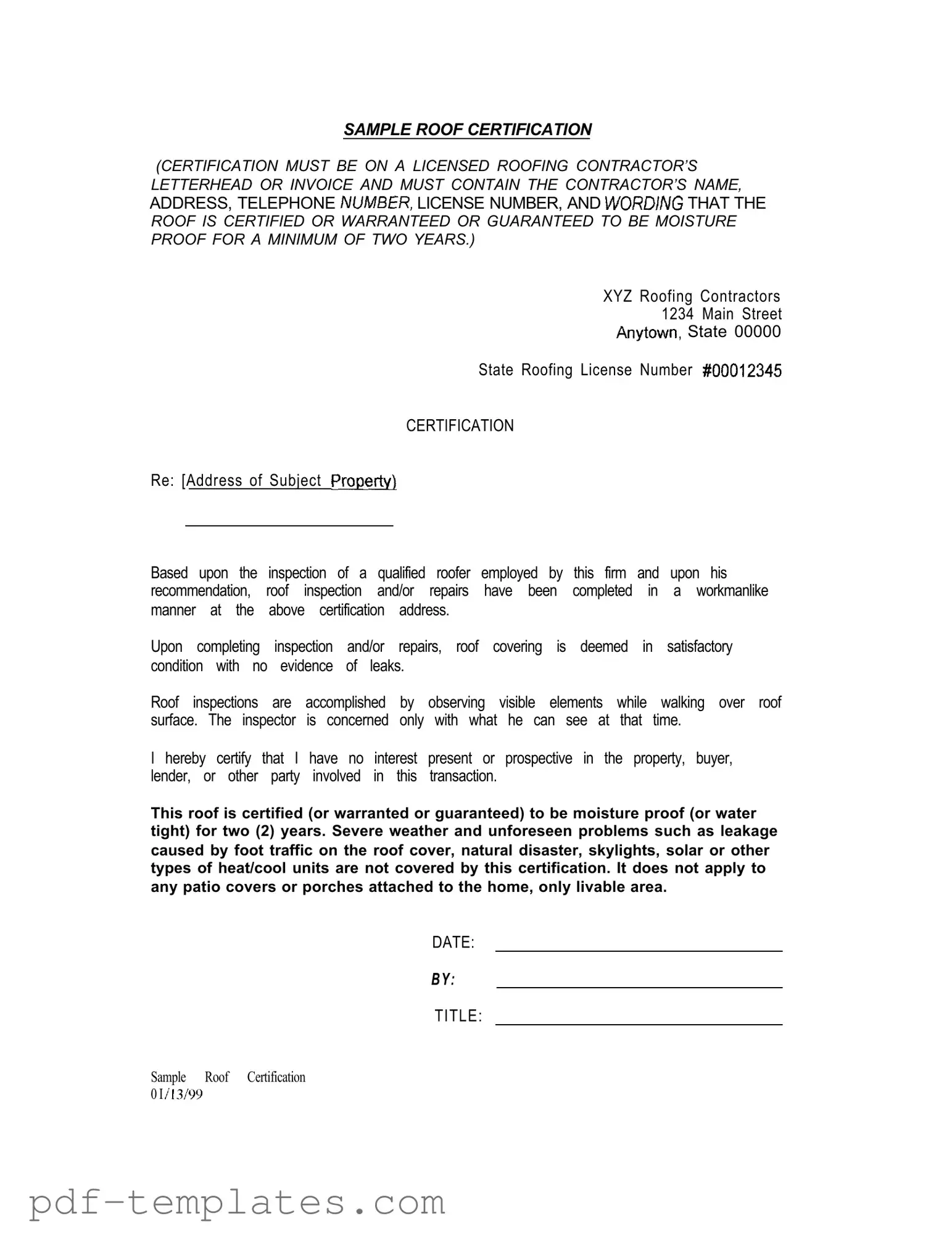The Sample Roof Certification form is similar to a Home Inspection Report. Both documents provide an assessment of a property’s condition, focusing on specific areas of concern. While the roof certification emphasizes the state of the roof and its ability to prevent moisture, a home inspection report covers a broader range of issues, including plumbing, electrical systems, and structural integrity. Both documents are often used in real estate transactions to inform buyers and lenders about the condition of the property, ensuring transparency and trust in the sale process.
Another comparable document is the Warranty Certificate for Roofing. This certificate guarantees that the roofing materials and workmanship meet certain standards for a specified period. Like the roof certification, it assures the property owner that the roof will perform as intended. However, the warranty certificate typically covers defects in materials and workmanship, while the roof certification focuses on the roof's current condition and its moisture-proof capabilities for a limited duration.
A Roof Inspection Report is also similar. This report is generated after a thorough examination of the roof by a qualified inspector. It details the findings of the inspection, including any necessary repairs or maintenance. While the roof certification provides a guarantee of moisture-proofing for a set period, the inspection report may not include such assurances but instead highlights the roof's current state and any potential issues that could arise in the future.
The Insurance Underwriting Report is another document that shares similarities. This report assesses the risk associated with insuring a property, including the condition of the roof. Insurers often require a roof certification to determine whether they will provide coverage and at what cost. Both documents serve as tools for evaluating the condition and longevity of the roof, impacting insurance premiums and coverage decisions.
A Property Condition Disclosure Statement is also relevant. Sellers often provide this statement to disclose known issues with the property, including the roof. Similar to the roof certification, it aims to inform potential buyers about the property's condition. However, while the roof certification guarantees moisture-proofing, the disclosure statement may only indicate known problems without providing assurances about the roof's performance.
The Maintenance Agreement for Roofing Services is another document that resembles the roof certification. This agreement outlines the terms for regular maintenance and inspections of the roof. Like the roof certification, it emphasizes the importance of maintaining the roof's integrity. However, the maintenance agreement focuses on ongoing care, while the certification provides a snapshot of the roof's condition at a specific time.
A Roofing Contract is also similar in that it details the terms and conditions under which roofing work will be performed. This contract includes information about the scope of work, costs, and timelines. While the roof certification confirms the completion of work and its satisfactory condition, the roofing contract establishes the obligations of the contractor and the expectations of the property owner.
The Seller's Disclosure Notice can also be compared to the roof certification. This notice is a legal document that sellers must provide, detailing any known defects or issues with the property, including the roof. Similar to the roof certification, it aims to protect buyers by ensuring they are aware of the property's condition before finalizing a purchase. However, the disclosure notice does not offer any guarantees about the roof's performance.
Completing the Trader Joe's application form is a crucial step for those eager to join the grocery chain, as it not only requires essential information but also allows applicants to highlight their individual skills and experiences. Understanding the importance of accuracy in filling out this form can significantly enhance the prospects of securing a position at one of their stores. For more details, you can access the application form here: https://documentonline.org/blank-trader-joe-s-application/.
The Final Walkthrough Checklist is another document that shares similarities. This checklist is often used by buyers before closing on a property to ensure that all agreed-upon repairs and conditions are met. While it may include a review of the roof's condition, it does not provide the same level of assurance as a roof certification. Instead, it serves as a tool for buyers to confirm that the property meets their expectations.
Lastly, a Real Estate Appraisal Report can be considered similar. This report assesses the value of a property, taking into account its condition, including the roof. While the roof certification specifically addresses the roof's moisture-proofing capabilities, the appraisal report evaluates the overall condition and market value of the property, which may influence financing and sale decisions.
